The Latest: Volcanic activity pauses at 12 Hawaii vents
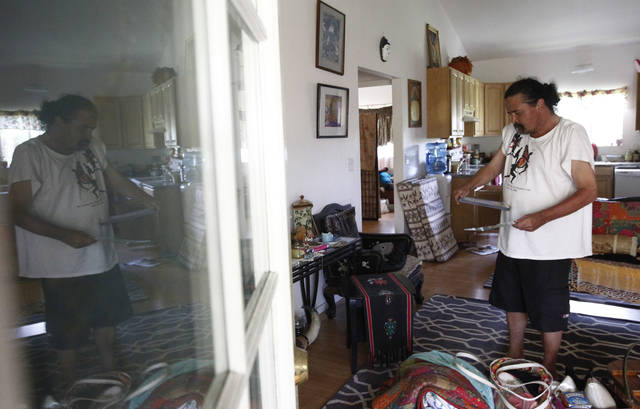
In this Sunday, May 6, 2018, photo, Leilani Estates resident Ken Peeler looks at photos while packing to evacuate his home in the Leilani Estates subdivision, in Pahoa, Hawaii. Hawaii’s Kilauea volcano has destroyed homes and spewed lava hundreds of feet into the air, leaving evacuated residents unsure how long they might be displaced. (Jamm Aquino/Honolulu Star-Advertiser via AP)
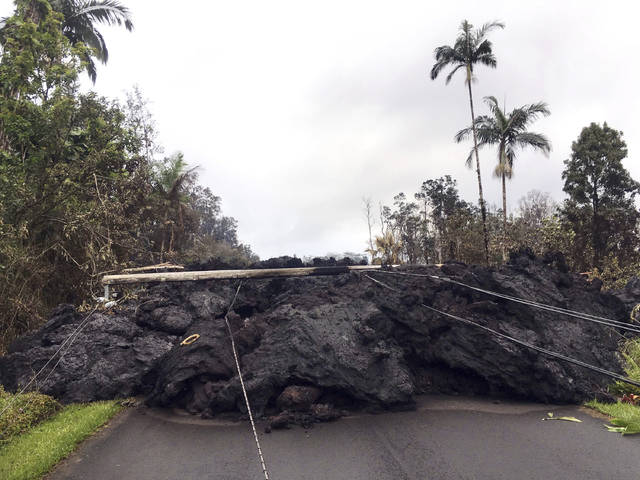
A street destroyed by lava in the Leilani Estates subdivision near Pahoa, Hawaii, is shown Tuesday, May 8, 2018. About 1,700 residents of the subdivision were ordered to evacuate after Kilauea began erupting May 3, 2018, destroying at least 26 homes. (AP Photo/Caleb Jones).
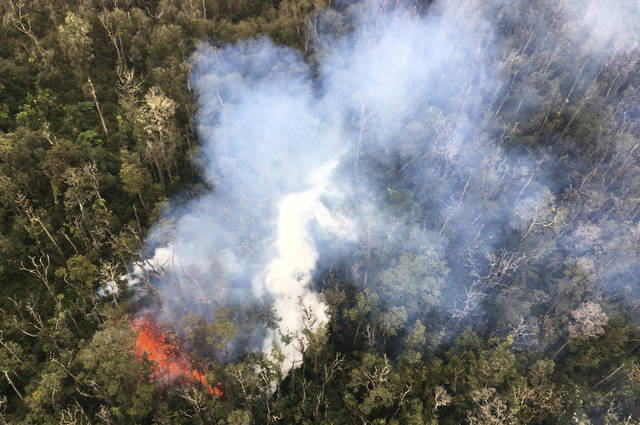
In this May 7, 2018 photo provided by the U.S. Geological Survey, smoke rises from a fissure in Leilani Estates in Pahoa, Hawaii. Hawaii’s erupting Kilauea volcano has destroyed homes and forced the evacuations of more than a thousand people. (U.S. Geological Survey via AP)
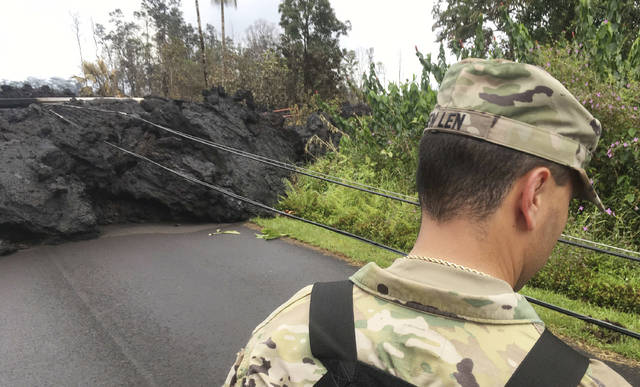
First Lt. Aaron Hew Len with the US National Guard surveys lava damage in the Leilani Estates subdivision near Pahoa, Hawaii, on Tuesday, May 8, 2018. About 1,700 residents of the subdivision were ordered to evacuate after Kilauea began erupting May 3, 2018, destroying at least 26 homes. (AP Photo/Caleb Jones).
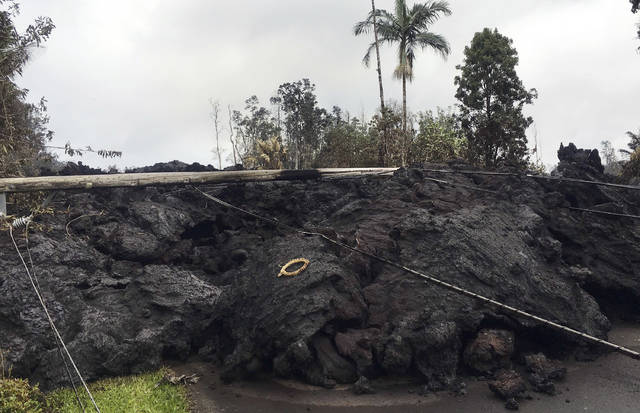
A street destroyed by lava in the Leilani Estates subdivision near Pahoa, Hawaii, is shown Tuesday, May 8, 2018. About 1,700 residents of the subdivision were ordered to evacuate after Kilauea began erupting May 3, 2018, destroying at least 26 homes. (AP Photo/Caleb Jones).
PAHOA, Hawaii — The Latest on lava pouring out from fissures caused by Kilauea volcano on the Big Island of Hawaii (all times local):
PAHOA, Hawaii — The Latest on lava pouring out from fissures caused by Kilauea volcano on the Big Island of Hawaii (all times local):
8:10 a.m.
Scientists confirm that volcanic activity has paused at all 12 fissures that opened up in a Hawaii community and oozed lava that burned 35 structures.
Officials warn that hazardous fumes continue to be released from the cracks in the ground.
Residents of the Leilani Estates subdivision were evacuated last week after the first fissure opened on a street.
They’re being allowed back to check on their properties again on Tuesday. Officials say they may return from 7 a.m. to 6 p.m. every day until further notice.
A nearby subdivision was also forced to evacuate. Officials aren’t allowing residents of Lanipuna Gardens back in because of dangerous volcanic gases.
The Hawaii County Civil Defense agency has set up a community information center at a church.
———
4:10 a.m.
Hawaii Gov. David Ige says he has called the White House and the Federal Emergency Management Authority to tell officials that he believes the state will need federal help to deal with the erupting volcano that has spewed lava from fissures and prompted evacuations.
Ige made the comments Monday when he met with people on Hawaii’s Big Island who have left their homes near the Kilauea volcano.
The eruption and lava has destroyed 26 homes.
Evacuated residents do not know how long they will be displaced.
Ige says he made the calls to federal officials because he believes it “was very important that we assure that state, federal and county assets would be available to keep” residents safe.
———
12 a.m.
As Hawaii’s Kilauea volcano spews lava and forces the evacuation of nearby homes, it can be difficult for people not from the Big Island to understand why anyone would risk living near an active volcano with such destructive power.
But the people here are largely self-sufficient and understand the risks of their location.
The slopes of Kilauea offer a lush rural setting and affordable land that contrasts sharply with Hawaii’s more expensive real estate.
Living on one of the world’s most active volcanoes comes with risks.
A dozen lava vents have opened in streets of the Puna district and 35 structures have burned.
The Puna district is a region of mostly unpaved roads of volcanic rock about a 30-minute drive from the coastal town of Hilo.
———
Kilauea volcano claims more than two dozen homes in Hawaii
PAHOA, Hawaii — Hawaii’s Kilauea volcano has destroyed 26 homes since it began spewing lava hundreds of feet into the air last week, and residents who evacuated don’t know how long they might bedisplaced.
The decimated homes were in the Leilani Estates subdivision, where molten rock, toxic gas and steam have been bursting through openings in the ground created by the volcano. Another four unspecifiedstructures were covered by lava, officials said in revised figures issued Sunday.
Some of the more than 1,700 people who evacuated were allowed to briefly return to gather medicine, pets, and other necessities. They will be able to do so each day as long as authorities believe it is safe.
Amber Makuakane Kane, 37, a teacher and single mother of two, said her three-bedroom house in Leilani Estates was across from a fissure that opened Friday. At the time, “there was some steam rising fromall parts of the yard, but everything looked fine,” Makuakane said.
On Saturday, she received alerts from her security system that motion sensors throughout the house had been triggered. She later confirmed that lava had covered her property.
Makuakane grew up in the area and lived in her house for nine years. Her parents live in the same subdivision.
“The volcano and the lava — it’s always been a part of my life,” she said. “It’s devastating … but I’ve come to terms with it.”
Lava has spread around 387,500 square feet (36,000 square meters) surrounding the most active fissure, though the rate of movement is slow. There was no indication when the lave might stop or how far itmight spread.
“There’s more magma in the system to be erupted. As long as that supply is there, the eruption will continue,” U.S. Geological Survey volcanologist Wendy Stovall said.
Cherie McArthur wondered what would become of her macadamia nut farm in Lanipuna Gardens, another evacuated neighborhood near Leilani Estates. One of the year’s first harvests had been planned forthis weekend.
“If we lose our farm, we don’t know where we’re going to go. You lose your income and you lose your home at the same time,” said McArthur, who’s had the farm for about 20 years. “All you can do is prayand hope and try to get all the information you can.”
About 250 people and 90 pets spent Saturday night at shelters, the American Red Cross said.
The number of lava-venting fissures in the neighborhood has grown to as many as 10, Stovall said, though some have quieted at various points. Scientists expect the fissures to keep spewing.
The lava could eventually be channeled to one powerful vent while others go dormant, as has happened in some previous Hawaii eruptions, Stovall said.
Kilauea (pronounced kill-ah-WAY’-ah), one of the world’s most active volcanoes, has been erupting continuously since 1983.
The USGS’s Hawaiian Volcano Observatory issued a notice in mid-April that there were signs of pressure building in underground magma, and a new vent could form on the cone or along what’s known as theEast Rift Zone. Leilani Estates sits along the zone.
The crater floor began to collapse on April 30, triggering earthquakes and pushing lava into new underground chambers that carried it toward Leilani Estates and nearby communities. On Friday, amagnitude-6.9 earthquake hit the area. It was Hawaii’s largest earthquake in more than 40 years.
The quake started Michael McGuire’s car rocking in his driveway, knocked things off his shelves and shattered glass in his cabinets near Leilani Estates. He hoped to check on his home Sunday but realized itwas too soon to be sure when, or if, it would be safe from the lava.
“I’m somewhat fatalistic. If it happens, it happens,” he said. “And I’m enjoying life here, so you know, you put up with a lot of things here. This is one of them.”
Noah and Laura Dawn own a retreat center about 3 miles downhill from the most active vents They were clearing out items Sunday and relocating up the coast indefinitely.
“We’re just removing all things of value to us and precious things because I have the feeling it could get real — real, real fast,” Noah Dawn said.
———
Peltz reported from New York and Yan from Honolulu. Associated Press photographer Marco Garcia and videographer Haven Daley contributed to this report from Pahoa.

